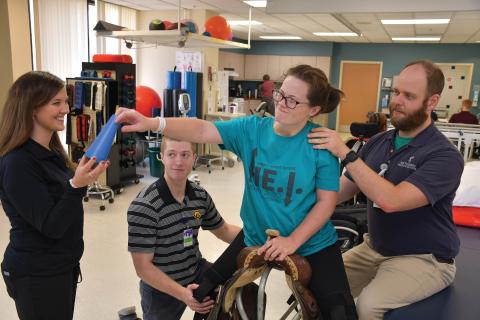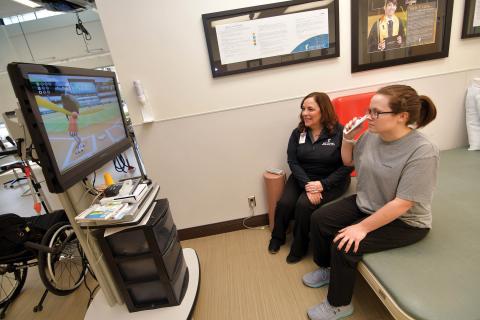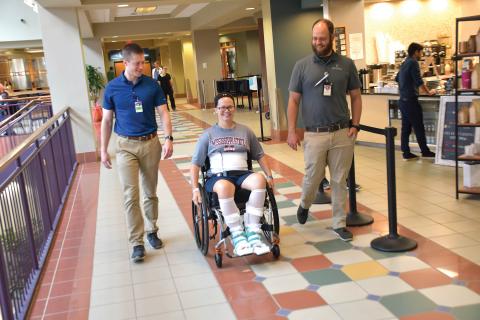
Country strong: Through therapy at MRC, Kalyn Smith strives to get back to the farm, back to college and back in the saddle after a life-changing horse-riding accident




After she broke her spine in a horse-riding accident, Kalyn Smith adjusted to her new normal the only way she knew how: by taking the reins.
“I remember when she first got here,” said Jacob Long, her physical therapist while at Methodist Rehabilitation Center in Jackson. “At the first session, she said ‘I want to do everything I need to do to get as mobile as I can, to get back out there and do the things I want to do.’”
For the 22-year-old self-professed country girl that means caring for her prized show cattle and her beloved horses on her family farm near Carthage.
When it came time for preparing Smith to do just that, her occupational therapist Stephanie Mimms got creative.
“I had seen a movie called ‘Walk, Ride, Rodeo,’” Mimms said. “It was about a barrel racer (Amberley Snyder) who had a spinal cord injury. When I spoke to Kalyn about it, she said she had actually met her a few years back through her involvement with Future Farmers of America.”
Smith had served as a state officer for the organization. “I asked if she wanted to ride again, and if she had a saddle that we could bring to the hospital to work on getting up on it.”
Of course, Smith was one step ahead and had already thought about doing just that.
“I borrowed the saddle from my best friend, and her brother brought it to me,” Smith said. “He said he got a lot of funny looks carrying it into the hospital. I wanted it so we could work on me transferring into the saddle. That was one of my big goals, getting back on a horse.”
Using the saddle was a great way for Smith to work on strengthening.
“I worked a lot with Stephanie on balance and being able to reach for things,” Smith said. “Because when I get back on a horse, I’m going to need to be able to open gates, reach down and fix my feet and be prepared for all the different movements a horse makes, like shaking off flies, and going from trotting to running.”
Today, Smith attends Mississippi State University, where she is studying mechanical engineering. And at the family farm, Smith has gotten back to taking care of her show cattle. She uses an ATV in place of a horse to round them up, but her goal of getting back in the saddle is within reach.
Using her engineering know-how, Smith researched and designed a system that will allow her to take her horse from the stables and wheel up onto a platform to transfer into the saddle directly from her wheelchair. All that remains is getting it built–a proposition the long, hot summer delayed.
At those very stables Smith still cares for Goliath, the headstrong horse that changed her life forever. Some might get rid of an unruly horse, but not the ever-practical Smith.
“You can’t blame a horse for being a horse,” Smith said.
It was on July 21, 2019, when Goliath, then a new and as-yet-unnamed horse, threw Smith off at an arena in Arlington. Smith was showing a cousin how to barrel race after a morning at church.
“I was coming around the third barrel, when he decided to buck me off,” Smith said. “I went about 8 feet in the air, and when I hit the ground, I landed on my right shoulder, and that’s how it broke my spine. From then on I was really out of it.”
It took over half an hour for local responders to get to the arena’s remote location with a bus to transport her to the hospital. Luckily, a trauma nurse at the scene recognized the need for Smith to be airlifted.
“I told her it felt like I had a rock in my back, and she said we’re not taking you on that bus, we’re getting you a helicopter to take you to the University of Mississippi Medical Center,” Smith said.
At UMMC, Smith underwent a surgery to decompress her spine, placing a rod in it at the T4 level, just above the complete fractures she sustained at the T5 and T6 level.
After recovery, Smith transferred to MRC to begin her rehab.
“I didn’t know anything about Methodist or any hospitals at all really,” Smith said. “That was the first time I had ever been in a hospital. If I ever got hurt, which was rare, I just went to a hometown doctor. But I didn’t have a doubt in my mind about going to Methodist because it was close to home. I wanted to be somewhere I could have family visit me every day.”
There, Smith began learning to live her life in a wheelchair.
“When I first got there, I didn’t even know what a ‘transfer’ was, and I sure couldn’t do them by myself,” Smith said. “I was really scared of falling. Jacob and Stephanie really helped a lot with that.”
Long is a certified Seating and Mobilty Specialist (SMS), which makes him specially qualified for making wheelchair and mobility recommendations.
“My focus on the front end was getting her fitted for a chair,” said Long.
Smith says watching Long perform the ins and outs of wheelchair customization brought out her inner engineer.
“He was changing around all these different parts and tweaking stuff,” Smith said. “That really appealed to me.”
But it wasn’t all fun for her learning to use a wheelchair.
“I hated when Jacob made me do wheelies in the wheelchair,” Smith said. “I was terrified of falling backwards. But I knew it was important to learn to do things like go over a curb. By the time for me to leave the hospital, I was asking him if we could do them.”
Mimms says a big part of Smith’s early therapy was preparing her for activities of daily living, known in therapy parlance as ADLs. This includes things like getting dressed, using the restroom and cooking.
“She was quite limited at first by range of motion and pain,” Mimms said. “And there was a learning curve with her new diagnosis for things like getting ready in the morning and transferring out of bed. But she was always open-minded and willing to try her hardest.”
Smith’s open-mindedness was put to the test when Mimms, who is a certified yoga instructor, introduced her to that exercise regimen, which was something unfamiliar to a lifelong country girl. But it didn’t take long for her to latch onto its value for her recovery.
“I wasn’t very flexible–I couldn’t hardly ever reach my toes, even before the accident,” Smith said. “But that was important for putting shoes and socks on, so we did a lot of yoga and stretching.”
In all, Smith spent 45 days at MRC, preparing her to adjust to home life in a wheelchair. But after a brief stint at home, she was ready to continue her therapy at Methodist Rehabilitation Center’s outpatient neurological rehabilitation clinic in Flowood.
“When I got there, my transfers had gotten better–I could do them on my own,” Smith said. “So my big thing for outpatient was getting ready for school. My main goal was being able to do everything on my own I needed to do.”
At Flowood, Smith worked with occupational therapist Pat Baird, who was struck by Smith’s can-do attitude.
“She is an amazing young lady,” said Baird. “I have three P’s I’d use to describe her. She was progressive–she was really always one step ahead of us. If there was an activity we mentioned for her to try and do, she had already developed a plan or how she was going to be independent with it and researching assistive equipment to help.
“She was proactive–she didn’t wait for us to finish teaching her, she would be working on things on her own at home. And she was above all positive. From the get-go, she was completely optimistic yet realistic about her condition and diagnosis. And she was unafraid to share her Christian faith and how it related to her going forward and progressing in life.”
Smith also continued strengthening with physical therapist Karen Klein.
“I worked with Kalyn on getting her as strong as possible and as independent as possible from her wheelchair,” Klein said. “She wanted to make it on her own at her apartment at school and she didn’t want to have to depend on someone to help her.”
Klein worked with Smith using a FES (Functional Electrical Stimulation) cycle. FES cycles use electrical current to stimulate nerves and evoke muscle contractions that allow patients with paralysis or muscle weakness to “pedal” exercise bikes with their arms or legs. She says they also continued to work on Smith perfecting her transfers in and out of the wheelchair “pretty much non-stop.”
“What I found most admirable about Kalyn was she never looked at her wheelchair as something that would stop her from getting where she wanted to go in life,” Klein said.
With her goal of complete independence, traveling to outpatient therapy put into focus another obstacle for Smith to overcome.
“I told them that I wanted to drive,” Smith said. “I got tired of having to ask people to take me places or wait for people to get off work or something to give me a ride. You don’t realize how much freedom driving gives you until it’s taken away.”
With that goal in mind, Smith’s therapists recommended she enroll in Methodist’s Quest Program, which is located at Methodist Outpatient Therapy in Ridgeland. There, occupational therapist Allison Harris offers a Driver Rehabilitation Program to certify patients to get back behind the wheel after an injury or illness. Quest’s therapists also work closely with patients who wish to return to school to prepare them for any challenges they may encounter.
Harris says Smith’s ingenuity helped her immensely with driving rehab and therapy.
“She got a lot of it figured out on her own, she was a real go-getter,” Harris said. “It was almost like we were her supporting cast! She’d come in with ideas of what to work on. Before we even started driving, she already knew what kind of vehicle and equipment she wanted. In therapy, we worked a lot on trunk balance and endurance because she wanted to get back in the saddle. We worked with her using a saddle just like she did in inpatient. I’d have to say that was a first for us.”
“When she got here, she was doing great with all her transfers,” said physical therapist Erin Perry. “So we worked on getting up and down off the floor, which we simulated with a mat. And she nailed it the first time. We also worked a lot on standing and being able to tolerate an upright position and regulating her blood pressure and heart rate. Of course, she eventually got her own standing frame for home so she could work on it on her own.”
But not long after Smith began her therapy at Quest, the COVID-19 pandemic hit.
“The pandemic messed everything up for a while,” Smith said. “I couldn’t come to therapy for about six weeks. Then I started coming back once a week, before going back to twice a week like normal. But then everything in therapy was just like usual–except for having to wear a mask and everything having to get wiped down and sanitized.”
As an occupational therapist, Harris usually conducts a site visit of the school patients are to attend to ensure proper accessibility, but that wasn’t possible with social distancing guidelines in place.
“While the pandemic hasn’t changed much what we do in the therapy gym, it has limited what we can do outside of therapy,” Harris said. “We were supposed to do a school visit for her but it got canceled. And at Quest, we regularly did outings–things like going to the store to practice shopping–so it’s limited some of that. As far as Kalyn goes, it hasn’t been a major issue, though.”
Smith “graduated” from Quest in July, and she was excited to finally get to go to school in August. It’s been a long time coming.
“I was originally supposed to move into my apartment in Starkville the Monday after my accident,” Smith said.
Smith is laser-focused on earning her degree, which should be no sweat for her. As she showed time and again during her time at Methodist, Smith sees no limit to what the future holds for her.
“Whatever it is I end up doing after school, I want it to be hands-on, because that’s what I like,” Smith said. “I know I want to be on a design team. I could see myself going into medical engineering. Because of all I’ve been through, I’ve got a different perspective than other people do.”
